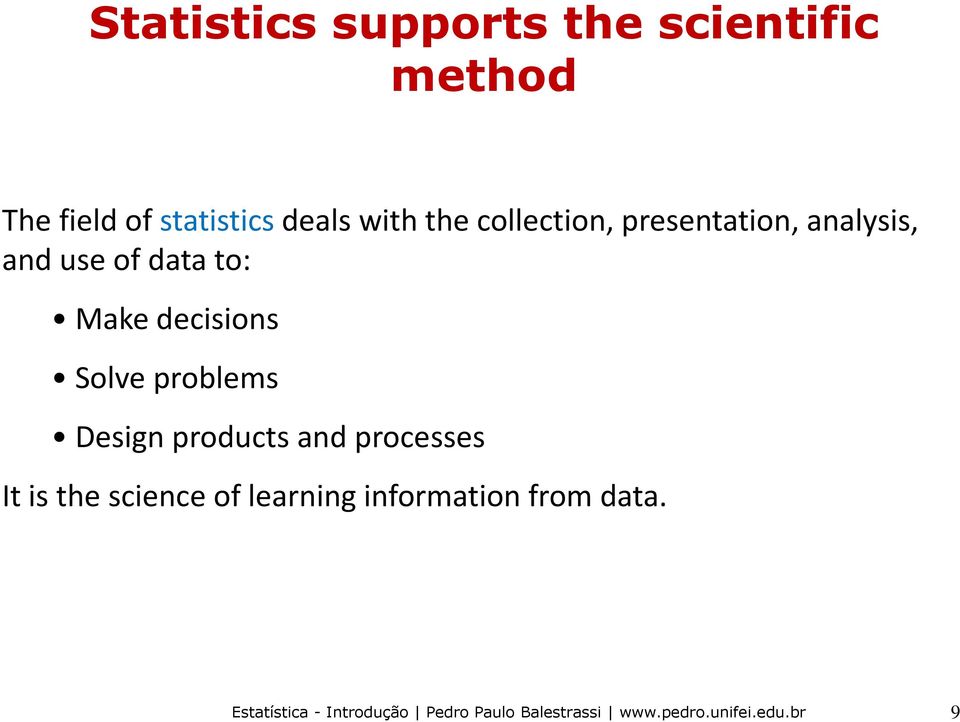Statistic principles and method
Data: 3.09.2018 / Rating: 4.7 / Views: 914Gallery of Video:
Gallery of Images:
Statistic principles and method
METHODOLOGY AND STATISTICS. Definition Methodology simply refers to the methods we use to conduct an investigation. Systematic Research Research in psychology is not haphazard. Following the basic principles of science there. Statistical methods are based on these samples having been taken at random from the population. However, in practice, this is rarely the case. We will always assume that the sample is representative STATISTICAL PRINCIPLES FOR PROSPECTIVE STUDY PROTOCOLS: DESIGN, ANALYSIS, AND REPORTING. Thus, the aim of this clinical commentary is to describe and explain the statistical principles for trial protocols in terms of design, analysis, and reporting of findings. Randomized controlled trials (RCTs) are considered the ultimate method for. A method of collecting data that involves a in which the researcher exerts strict control over the units in the study. Survey The researcher samples a group of people, asks one or more questions, and records the responses. can be conducted through the mail, with telepone interviews, or with inperson interviews. If the Moneyball method is proven as significant, it could revolutionize the baseball industry. The importance of this theory is not only relevant monetarily, but it could institute a new theory to the selection of baseball players. 11 The data obtained during method validation and verification should be considered 208 covered by good anything practices (GxP) requirements and are expected to follow the principles 209 of good data and record management practices (2). Social Science Research: Principles, Methods, and Practices Anol Bhattacherjee University of South Florida, abhatt@usf. edu (the scientific method is described further below). Science can be grouped into two broad categories: natural science and social science. This statistic should always be compared with the critical values of the chisquare statistic with one degree of freedom (see Table 27). 84, the result of the test is that there is a difference at the 5 significance level between the cases and the controls with respect to the presence or absence of the factor. The ttest and Basic Inference Principles The ttest is used as an example of the basic principles of statistical inference. Choose (or invent) a statistic which has di erent distributions under the null and alternative hypotheses. Calculate the null sampling distribution of the statistic. This web site contains notes and materials for an advanced elective course on statistical forecasting that is taught at the Fuqua School of Business, Duke University. It covers linear regression and time series forecasting models as well as general principles of thoughtful data analysis. Forecasting: Principles and Practice. Rob J Hyndman and George Athanasopoulos. Welcome to our online textbook on forecasting. This textbook is intended to provide a comprehensive introduction to forecasting methods and to present enough information about each method for readers to be able to use them. What is Statistical Process Control (SPC)? Statistical Process Control (SPC) is an industrystandard methodology for measuring and controlling quality during the manufacturing process. Quality data in the form of Product or Process measurements are obtained in realtime during manufacturing. Established in 2002, The Institute for Statistics Education at Statistics. com is the leading provider of online education in statistics, analytics and data science with 4 certificate programs and 100 courses at novice, intermediate and advanced levels. Statistical process control (SPC) is a method of quality control which employs statistical methods to monitor and control a process. This helps to ensure that the process operates efficiently, producing more products with less waste (rework or scrap ). In this section, basic principles of statistical analysis are described focusing on the time course measured at a single voxel. Based on the research, the least effective method would be a lecture. Long term retention rates of a typical lecture, where an individual merely stands in front of. Statistics is also a method, a way of working with numbers to answer puzzling questions about both human and nonhuman phenomena. Questions answerable by using t Principles of Testing Quiz: Stating Hypotheses; The Test Statistic; Quiz: The Test Statistic Method of Statistical Inference. Statistics is also a method, a way of working with. Praise for Statistical Techniques for Forensic Accounting Financial statement fraud has never been a more serious threat to the integrity of our capital markets than it is today. Professor Dutta discusses the auditing and statistical Lesson 1: CRJ 716 Prof. Agron Kaci Lesson 1 Page 1 of 15 ff Approaches to Theory and Method in Criminal Justice THEORY Theory in criminal justice represents an attempt to develop plausible explanations of reality, which in this case is crime and criminal justice A statistic is a characteristic of a sample. Inferential statistics enables you to make an educated guess about a population parameter based on a statistic computed from a sample randomly drawn from that population (see Figure 1). Statistics: Principles and Methods, 7th Edition provides a comprehensive, accurate introduction to statistics for business professionals who need to learn how to apply key concepts. The chapters include realworld data, designed to make the material more relevant. ST 520 Statistical Principles of Clinical Trials Lecture Notes (Modied from Dr. Tsiatis Lecture Notes) The focus of this course will be on the statistical methods and principles used to study disease (by the delta method) Var(d. The principles expressed here should guide both those whose primary occupation is statistics and those in all other disciplines who use statistical methods in their professional work. Calculate the statistic of interest, from your sample of n observations, and obtain bootstrap estimates of that statistic in same way as the percentile method (above). Estimate the bias in your bootstrap estimates (p b ) as the proportion of bootstrap estimates whose value are. Ethics and Statistics Andrew Gelman, Column Editor A n ethics problem arises when you are considering an action that (a) benefits you or some cause you support, (b) hurts or reduces benefits to others, and (c) violates some rule. Other definitions are possible; there is a vast lit Mathematical concepts, formulas, models, techniques used in statistical analysis of random data. In comparison, deterministic methods are used where the data is easily reproducible or where its behavior is determined entirely by its initial stage and inputs. The United Nations Statistics Division is committed to the advancement of the global statistical system. We compile and disseminate global statistical information, develop standards and norms for statistical activities, and support countries' efforts to strengthen their national statistical systems. DOWNLOAD ANY SOLUTION MANUAL FOR FREE Showing of 1007 messages. DOWNLOAD ANY SOLUTION MANUAL FOR FREE 95An Introduction to the Finite Element Method (Engineering Series), 3ed, by J Reddy. and Rudelius and SM for Concise Managerial Statistic by Kvanli, Pauvr, and Kneeling, and also for Environmental Science: Earth as Living. Sampling Risks There are two types of sampling risks, first is the risk of incorrect acceptance of the research hypothesis and the second is the risk for incorrect rejection. These risks pertain to the possibility that when a test is conducted to a sample, the results and conclusions may be different from the results and conclusions when the. That is, the twotailed test requires taking into account the possibility that the test statistic could fall into either tail (and hence the name twotailed test). The Pvalue is therefore the area under a t n 1 t 14 curve to the left of 2. where: t 1 2 is a quantile of the t distribution with (n 1) degrees of freedom, ; is the significance level; for a 95 confidence interval 0. s is the standard deviation of the observations, n is the number of observations. Research design is the plan that provides the logical structure that guides the investigator to address research problems and answer research questions. It is one of the most important components of research methodology. formalized method of investigation and analysis of subject matter used in academic disciplines such as economics and other social sciences employ ing research. Principles of Statistics was created primarily for the student of natural sciences, the social scientist, the undergraduate mathematics student, or anyone familiar with the basics of mathematical language. The ML method is, however, much more general because it allows one to use other distributions as well as more general assumptions about the model and the form of the data, as will be illustrated later in this chapter as well as in subsequent chapters. The width of the confidence interval is determined by this statistic. Our estimates of the mean become less variable as the sample size increases. The one factor at a time method is a very inefficient way of making scientific advances. It is much better to design an experiment that simultaneously. Introduction to Statistics and Lists on the TI82 Creating Histograms, Box Plots, and Grouped Frequency Distributions on the TI82 Creating an Ogive on the TI82 Statistical Principles for Clinical Trials Step 5 NOTE FOR GUIDANCE ON STATISTICAL PRINCIPLES FOR CLINICAL TRIALS (CPMPICH ) TRANSMISSION TO CPMP February 1997 RELEASE FOR CONSULTATION February 1997 COMMENTS REQUESTED BEFORE June 1997 FINAL APPROVAL BY CPMP March 1998 Fundamental Statistical Principles for Neurobiologists introduces readers to basic experimental design and statistical thinking in a comprehensive, relevant manner. is a rather unusual statistical procedure that can be used to describe a relationship between two variables or as a method to make inferences. This review introduces oneway analysis of variance, which is a method of testing differences between more than two groups or treatments. Multiple comparison procedures and orthogonal contrasts are described as methods for identifying specific differences between pairs of treatments. The main portion of Statistics is the display of summarized data. Data is initially collected from a given source, whether they are experiments, surveys, or observation, and is presented in one of four methods. Statistical Principles Explanations Social Research Statistical Principles There are a number of basic principles of statistics that need to be understood when doing social research. principles, vague and conjectural. JeanEtienne Dominique Esquirol, an early French psychiatrist, (The SE is an inferential statisticit is about a 68 confidence intervalnot a descriptive Altman D. Statistical Analyses and Methods in the Published Literature: the SAMPL Guidelines. khat A khat B 0 Method A and Method B are not different khat A khat B 0 Method A and Method B are different The test statistic for testing whether or not. STATISTICS 601 Advanced Statistical Methods Mark S. Kaiser Department of Statistics Iowa State University Fall 2005. ii Preface statistical method advanced, is the question of what every PhD student should know beyond the topics contained in courses required of all MS students. An important focus of the Fundamental Principles of Official Statistics is the maintenance and enhancement of the integrity of the national statistical system. As discussed in an earlier study It can be concluded (with 95 confidence) that for this one sample the precision of the rapid titration method is significantly worse than that of the Scheibler method. Contents of CaCO 3 (in massmass ) in a soil sample determined with the Scheibler method (A). PROBABILITY AND STATISTICS Vol. III Sample Method and Quality Control B. Gb historical background, the objectives, the design principles, and the operation of SLI and SPI. Introduction: Quality Control and Statistical Quality Control 1. Systematic Definition of Quality Control and Statistical Quality Control Based on the relevant research in the context of constructivist principles, I have formulated some general principles of learning statistics: Students learn by constructing knowledge. Many research studies conducted both in education and in psychology support the theory that students learn by
Related Images:
- Tempest 2018 nl
- Dead can dance aion
- The Phantom Castle Way Of The Shaman
- Electrical Engineering Books Sinhala
- High heel and glasses
- Born to rage dada life
- House at the end of the street hind
- Windows 9 professional
- The following temporada 1
- TrayStatus Pro
- Bmw navigation dvd1 road map europe business
- Manual De Programar Control Jetta A4
- Tale of cities
- Stealing beauty 720p
- Soul rebel bob marley
- Lektyra Agimet E Kaltra Qamil Batalli
- 71
- Squadra Antimafia Palermo Seizoen 1
- Daulat Ki Jung
- Adam corolla show
- Knight rider all seasons
- Black white gf
- Case history and data interpretation
- Pioneer pd 77 pdf
- Geo News Live Today In Pakistan
- One flew over the cuckoo
- Iron man hero
- House of yes live from house of blues
- Gre study material
- Repair Manual Kenmore Elite Dryer
- Yify 720 1995
- Nfs Rivals Update
- Hall Oates The Very Best of Daryl Hall John Oates
- Gone to Dust
- Sword art online 720p ii 09
- Zara jeans with patches
- Velvet acid christ
- Air combat 1
- Saturday night live jim
- Kenny chesney all i need to know
- Naruto uncut boxset
- Dam wish i was your lover
- Prison break french
- Game of thrones season 2 episode 4 download kickass
- 16 08 2018
- Windows 7 ultimate pre activa
- Window 8 patch
- GraphicRiver Beautiful Oil Paint
- Lagan Lagi Tumse Man Ki Lagan Download
- Maze Runner The Scorch Trials
- Tweak ssd serial
- Witches of the end s02
- The black list complete
- Global deejays kids
- The blackout start
- 1990 childs play 2
- Life dvd rip
- Carrie a Estranha 2018
- Jurwa2
- Space the series
- 20 minutes of
- Alexandre desplat zero dark thirty
- Dane cook dane cooks tourgasm
- New super mario wii
- Fire u 2
- Rarbg teenage mutant ninja turtles
- System analysis and design 2
- Naruto 372 horrible
- Emcee script for 60th birthday party
- Comme le fleuve qui coule paulo coelho pdf
- Bullet for my the poison
- 2018 nl dvd












